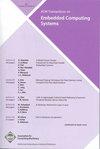ViT4Mal: Lightweight Vision Transformer for Malware Detection on Edge Devices
IF 2.6
3区 计算机科学
Q2 COMPUTER SCIENCE, HARDWARE & ARCHITECTURE
引用次数: 1
Abstract
There has been a tremendous growth of edge devices connected to the network in recent years. Although these devices make our life simpler and smarter, they need to perform computations under severe resource and energy constraints, while being vulnerable to malware attacks. Once compromised, these devices are further exploited as attack vectors targeting critical infrastructure. Most existing malware detection solutions are resource and compute-intensive and hence perform poorly in protecting edge devices. In this paper, we propose a novel approach ViT4Mal that utilizes a lightweight vision transformer (ViT) for malware detection on an edge device. ViT4Mal first converts executable byte-code into images to learn malware features and later uses a customized lightweight ViT to detect malware with high accuracy. We have performed extensive experiments to compare our model with state-of-the-art CNNs in the malware detection domain. Experimental results corroborate that ViTs don’t demand deeper networks to achieve comparable accuracy of around 97% corresponding to heavily structured CNN models. We have also performed hardware deployment of our proposed lightweight ViT4Mal model on the Xilinx PYNQ Z1 FPGA board by applying specialized hardware optimizations such as quantization, loop pipelining, and array partitioning. ViT4Mal achieved an accuracy of ~94% and a 41x speedup compared to the original ViT model.ViT4Mal:用于边缘设备恶意软件检测的轻量级视觉转换器
近年来,连接到网络的边缘设备有了巨大的增长。虽然这些设备使我们的生活更简单、更智能,但它们需要在严重的资源和能源限制下执行计算,同时容易受到恶意软件的攻击。一旦受到攻击,这些设备就会被进一步利用,成为针对关键基础设施的攻击媒介。大多数现有的恶意软件检测解决方案都是资源和计算密集型的,因此在保护边缘设备方面表现不佳。在本文中,我们提出了一种新的方法ViT4Mal,它利用轻量级视觉变压器(ViT)在边缘设备上进行恶意软件检测。ViT4Mal首先将可执行字节码转换为图像来学习恶意软件的功能,然后使用定制的轻量级ViT来高精度地检测恶意软件。我们进行了大量的实验,将我们的模型与恶意软件检测领域最先进的cnn进行比较。实验结果证实,vit不需要更深层的网络来达到与高度结构化的CNN模型相对应的97%左右的准确度。我们还在Xilinx PYNQ Z1 FPGA板上对我们提出的轻量级ViT4Mal模型进行了硬件部署,方法是应用专门的硬件优化,如量化、循环流水线和阵列分区。与最初的ViT模型相比,ViT4Mal实现了约94%的准确率和41倍的加速。
本文章由计算机程序翻译,如有差异,请以英文原文为准。
求助全文
约1分钟内获得全文
求助全文
来源期刊

ACM Transactions on Embedded Computing Systems
工程技术-计算机:软件工程
CiteScore
3.70
自引率
0.00%
发文量
138
审稿时长
6 months
期刊介绍:
The design of embedded computing systems, both the software and hardware, increasingly relies on sophisticated algorithms, analytical models, and methodologies. ACM Transactions on Embedded Computing Systems (TECS) aims to present the leading work relating to the analysis, design, behavior, and experience with embedded computing systems.
 求助内容:
求助内容: 应助结果提醒方式:
应助结果提醒方式:


